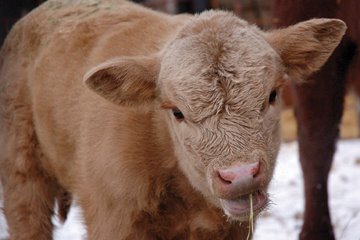It's Time to Send a Message
by Brian Sterling
As I chugged along in my old 1070 Case to feed the cows this morning, I passed by brush covered in hoar frost and sloughs alive with sparrows as a snowy owl sat high up surveying the landscape.
The cold snap has let up a bit and everything was quite pretty—even serene. Two moose were happily eating the corn cobs that are supposed to be fodder for the cattle later. The moose had guests - at least 50 deer had joined them for the morning smorgasbord. I also saw three coyotes, a fox, a dozen prairie chickens and a badger all in a matter of 10 minutes on that mile long drive to where the cows were patiently waiting.
Thankfully this morning the fuel line didn’t gel up so there was nothing to distract me from my thoughts that were on a presentation I had attended the day before in Winnipeg.
The presenter was with the government and a person with some influence. The usual comments were made that livestock are an environmental hazard; that cows are polluters and if we got rid of the cows the world would right itself.
At one point, he had to excuse himself for a few moments to use the washroom and I couldn’t help but wonder where that flush would end up—where they all end up—in the Red or Assiniboine rivers, and possibly making its way onto a market gardener’s field of carrots or grandpa’s backyard garden. The hypocrisy of focusing on cattle when there is a very real problem of human waste in the river system is astounding.
All that aside, my point is this: the livestock industry is one of the few that preserves the natural capital of the landscape and is an enhancement. It is not to our advantage to drain and burn. Trees are shelter and wetlands are the insurance policy in the event that the rains don’t come.
If cows weren’t here on this farm, neither would there be bush, wetlands in the old buffalo wallows, the dam that created a small duck and goose habitat, the standing corn or the hay in the slough bottoms. This land would be drained and scrubbed and some poor guy would be trying to grow grain. That is just the way it is and many of the cattle operations in this area are being forced in that direction because of these tough economic times.
And who or what will suffer if this pattern continues? The hunters and others who like to come here for a Sunday drive; the wildlife that will be forced to move elsewhere - if there is anywhere else left to move to. The biodiversity of the landscape will be no more.
It is so easy to look at a photo of the old cow on the wall of a cosy 14th floor office in a building downtown, and accuse her of being a polluter. And because we cattlemen are not hypocrites, will admit that in some respects she is. But I challenge others to hear and understand that is such a small part of the story.
If we are going to talk about pollution and emissions then let’s also talk about off-sets and carbon sinks the cow and her calf provide. The cow herd can do many things—provide many environmental services to the public—because the cow is a multi-functional animal, capable of being a huge environmental asset.
It is time cattle producers shouted this message. And it is time the rule makers and regulators start listening to the truth in that message.
- Brian Sterling is the Chairman of the MCPA’s Environmental Committee.
Welcome to the Online Edition of Cattle Country!
Updated with every new issue
Past issues will be available in the archive. If you are interested in reading Late Breaking News between paper deadlines, scroll down to the bottom of the page. The most recent information will be posted first.
Past issues will be available in the archive. If you are interested in reading Late Breaking News between paper deadlines, scroll down to the bottom of the page. The most recent information will be posted first.

Thursday, February 12, 2009
Subscribe to:
Post Comments (Atom)

No comments:
Post a Comment